All 6 entries tagged Late Antiquity
View all 7 entries tagged Late Antiquity on Warwick Blogs | View entries tagged Late Antiquity at Technorati | There are no images tagged Late Antiquity on this blog
February 09, 2024
A “Vota Publica” token of the usurper Nepotian?
Among the numerous Roman tesserae and coin-like objects that have been emerging on the market in recent years is an unusual specimen made of bronze, which can be associated to the “Vota Publica” token series (AD 305/306 – c. late fourth century) (Fig. 1). As is comparatively known, this late Roman emission consists of two clusters displaying the portrait of a Roman emperor or an Egyptian deity (Serapis, Isis, Hermanubis) on the obverse – hence they have been respectively named as “imperial” and “anonymous” series – which share a set of ritual scenes referring to different aspects of Egyptian and Isiac cults on the reverse, mostly accompanied by the legend “Vota Publica’” (= “public vows”).
On the obverse of the focused token is a bare-headed, draped, male bust facing right, with a pointed nose, a short, grape–shaped beard, and a coiffure with straight hair except for a row of curls on his forehead, which is accompanied by the legend DEO SE-RAPIDI in the dative case (“to the god Serapis”). This portrait has none of the typical features of Serapis iconography, such as a mature look, a voluminous beard, and above all a grain measure called a modius or kalathos worn as a headdress (accompanied by a radiate crown in some variants), which regularly typify the Egyptian god on the tokens from the “anonymous” group (Figs. 2-3). It should thus represent a different male figure which is not otherwise identified by the legend. On the reverse is a draped (and veiled?) female figure standing front, head turned l., holding uncertain objects in each hand, accompanied by the peculiar legend VOTA P-VBLICA. These two obverse and reverse types are unrecorded and are therefore worthy of closer examination.
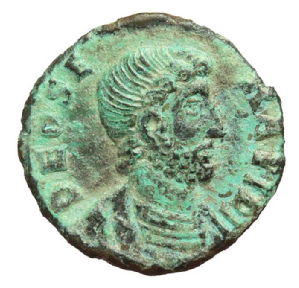 |
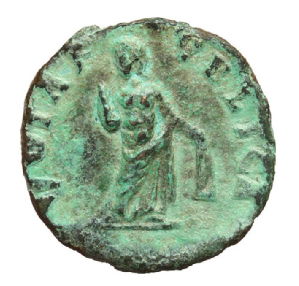 |
Figure 1: Æ “Vota Publica” token (15mm, 1.59g, 11h). Artemide Aste 19.1E, 20-21 October 2012, lot 381. Reference: L. Bricault & C. Mondello, Isis Moneta. The ‘Vota Publica’ tokens from late antique Carthage and Rome (forthcoming), cat. no. E169.1.
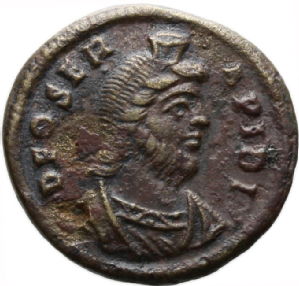 |
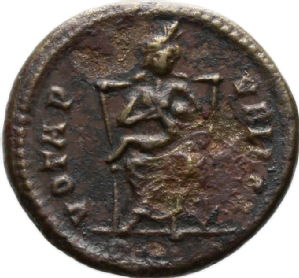 |
Figure 2: Æ “Vota Publica” token (19mm, 2.93g). Ashmolean Museum (inv. HCR71378, Douce coll.). Reference: L. Bricault & C. Mondello, Isis Moneta. The ‘Vota Publica’ tokens from late antique Carthage and Rome (forthcoming), cat. no. S83.1.
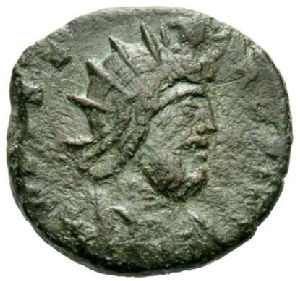 |
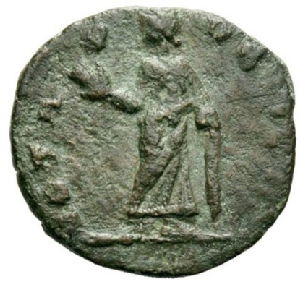 |
Figure 3: Fig. 3: Æ “Vota Publica” token (18mm, 2.52g). Gorny & Mosch 278, 21.04.2021, lot 3851. L. Bricault & C. Mondello, Isis Moneta. The ‘Vota Publica’ tokens from late antique Carthage and Rome (forthcoming), cat. no. S86.3.
The specimen, with a module of 15mm and a weight of 1.59g, was offered for sale in an online auction about ten years ago but remained unsold. In the relevant auction catalogue, the token was given as a very rare (genuine) piece (“RRR”). As for the imagery, the commentator identified the obverse portrait as the emperor Julian (AD 361-63) and described the female figure on the reverse as Isis, holding a sistrum in her right hand and situla in her left (sic). Nevertheless, this description does not appear to be supported by the evidence provided by the official coinage nor by the obverse and reverse depictions occurring on the surviving “Vota Publica” tokens.
Julian’s portrait as Augustus (AD 361-363) is commonly figured on coins in the guise of a draped and double–pearl diademed bust, with a mostly long and pointed beard, either wearing military clothing or consular garb; with such features it also recurs in some of the “Vota Publica” token issues, where the ruler is clearly identified by the legend D N FL CL IVLI-ANVS P F AVG or FL CL IVLIA-NVS P F AVG. Inspired by the Greek philosopher’s model, the short or long-bearded portrait of the last ruler of the Constantinian dynasty constituted a “revolutionary” innovation with respect to the iconographic tradition of the new clean–shaven portrait of the emperor in late antiquity which was established by Constantine I (AD 306-337). However, the Julian-type portrait of the Julian type failed to prevail over the Constantinian imperial portrait model which, inspired by Augustan and Trajanic imagery, was later followed by most emperors in the West and East across the fourth and fifth centuries.
Although the male portrait in Fig. 1 is also bearded as in the case of Julian, its general features do not match the latter’s coin portraiture. Closer parallels can instead be found in the coin images of another fourth-century bearded ruler, the usurper Nepotian.Son of Virius Nepotianus and of Eutropia (half-sister of Constantine I), seemingly born after the dynastic purge by the sons of Constantine I in the summer of AD 337, Nepotian was hailed emperor by a mob on 3 June 350 after the revolt of Magnentius, and ruled the city of Rome as usurper for twenty-eight days, before being killed by his rival Magnentius’ magister officiorum Marcellinus. As a usurper, he struck coins in his own name (as well as in the name of Constantius II), the production of which was limited to the Roman mint and only consisted of two denominations, that is solidi and large billon AEs. On the two “Urbs Roma” and “Gloria Romanorum” series, the portrait of Nepotian occurs either bare-headed or rosette-diademed, with an oblong face shape, a peculiar hooked nose, a short beard, and curly or straight hair with a mostly wavy fringe.
As can be seen in Figs. 4 and 5, the vultus of Nepotian and general features of his coin portrait seemingly have some affinities with the bearded bust on the obverse of the focused “Vota Publica” token.* If this assumption is correct, such a relation may suggest that the former inspired or served as a model for the latter, although it must be said that there are some slight differences which are probably due to a different engraving style. On the other hand, in this author’s opinion, no remarkable parallels can be found with the few bearded portraits of the emperors or usurpers of the West and East on coins issued since the post-Tetrarchic period (e.g., Martinian, Vetranius, Procopius, Eugenius, Maximus of Hispania, Joannes), nor with those on Roman medallions and “contorniates” from the fourth and fifth centuries AD.
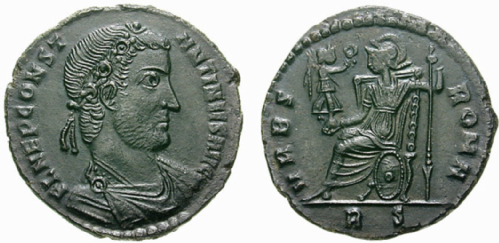 |
Figure 4: Large Æ2 (c. 24mm, 5.36g), usurper Nepotian (AD 350), “Urbs Roma” series (= RIC VIII, Rome 203).
|
|
Figure 5: Large Æ2 (5.05g), usurper Nepotian (AD 350), “Gloria Romanorum” series (= RIC VIII, Rome 200). Numismatik Lanz München, Auction 100, 20.11.2000, lot 581.
As for the reverse, the overall scheme of the type showing a female figure standing front in Fig. 1 is reminiscent of Isis’ common depiction, standing with her body supported on one leg, while brandishing a sistrum (a percussion musical instrument associated with her cult) or a palm branch in her right hand and a situla (a bucket for holy water), sometimes replaced by a patera (a libation bowl), in her left (e.g. Fig. 3). However, the draped figure on the token cannot be identified with the Isis as she lacks a basileion and other attributes which typify the goddess. The objects held by the figure remain difficult to decipher, which could maybe be interpreted as a branch of a not recognizable tree or plant in her right hand and a strip of drapery in her left. Therefore, this precludes to enlighten the precise nature of the reverse motif. Looking at the types belonging to the reverse figurative repertoire of the “Vota Publica” series, the female figure in question appears to be conceptually closer to the depictions of auxiliaries and participants in (Isiac?) religious ceremonies (e.g. torch and candelabra holders, canephores, female attendants, and devotees) (e.g. Fig. 6) than to those of the goddess Isis.
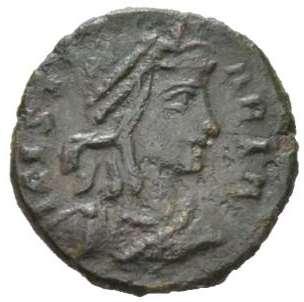 |
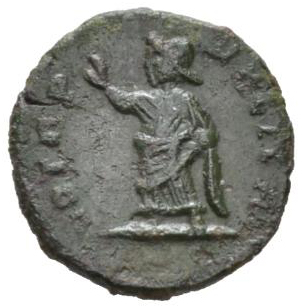 |
Figure 6: Fig. 6: Æ “Vota Publica” token (14mm, 1.41g, 12h). Naville Numismatics 12, 18.01.2015, lot 249. Reference: L. Bricault & C. Mondello, Isis Moneta. The ‘Vota Publica’ tokens from late antique Carthage and Rome (forthcoming), cat. no. I154.4.
Interestingly, this token mixes some features from the “imperial” series (= the depiction of a bust of an alleged Roman emperor or usurper on the obverse) and the “anonymous” one (= the obverse legend “Deo Serapidi”), which were both part of the “Vota Publica” token emission. As recently shown (Bricault & Mondello, forthcoming), the “imperial” series consists of a small first issue from the mint of Carthage dating back to the Second Tetrarchy (AD 305-306) and the Third Tetrarchy (AD 306-307), and a subsequent, large production from the mint of Rome struck from the reign of Constantine I (AD 313-330/331) through at least the first two generations of the Valentinian dynasty (AD 365-378). In contrast, the “anonymous” series is devoid of any chronological reference from which a reliable date can be inferred. Due to die-linkage with some of the Valentinianic groups from the “imperial” series, the “anonymous” series has commonly been regarded as a product of the Roman mint and dated to the years between AD 379-380 and 395, based on some stylistic and historical assumptions (Alföldi 1937, p. 17). However, it remains debated when the production of this undated series began and ended.
If the male portrait on the obverse of the outlined token was indeed intended to represent the usurper Nepotian or was at least borrowed from his official coinage, it may shed light on some aspects of the “anonymous” series manufacture. Among other options, one might consider the token as a trial piece or as part of a transitional group between the “imperial” and “anonymous” series by virtue of its mixed characteristics; or, it could even lead one to consider pre-dating the starting point of the “anonymous” series to AD 350.
However, in this author’s opinion, some remarks on the iconography of the specimen and its historical background may raise serious questions on its genuineness.
Not only are the types occurring on this token unattested, but even certain of their details look anomalous. Regarding the obverse, the anonymous male bust does not constitute a full copy of Nepotian’s coin portrait, as seen above. Rather, the former seems to arise from a re-working of the latter by the engraver, despite the close affinities between them. Noteworthily, the curls on the forehead of the male portrait on the token have a quite unnatural round shape, the appearance of which seems reminiscent of the rosettes forming the imperial diadem often occurring on fourth century Roman coins, including Nepotian’s Roman issues. One might imagine that the die-cutter misrepresented a rosette diadem as a sort of curly fringe when designing the obverse portrait on the token, maybe in an attempt to imitate one of Nepotian’s portraits occurring on the relevant Roman coin dies. In contrast, it seems unlikely that the curly fringe of the male bust’s hair is in fact to be understood as a rosette diadem, due to its position as jutting out on the forehead instead of being placed on the top of the head, as well as given the absence of any diadem’s ties which normally flowed down behind the ruler’s neck on coin imperial portraiture.
Moreover, the obverse of the token deviates from the epigraphic pattern attested on the extant pieces. In fact, the legend DEO SERAPIDI only accompanies the portrait of Serapis, Hermanubis, or even the jugate busts of Serapis and Isis on the obverses of the “anonymous” series, and is never combined with the portrait of a different figure.
Likewise, inconsistencies can also be found on the token’s reverse design. For instance, the right hand of the female figure and the object she bears were drawn as single whole here. As with the obverse type, this “oddity” could also result from an error or misrepresentation by the engraver, who maybe depended on one or other of the variant of Isis holding a palm branch in her right hand, as found on the reverses of the “Vota Publica” tokens. Moreover, it is worth noting that the style of both types has no parallels with any of the surviving “Vota Publica” tokens, which seem to have come out of a different workshop.
Further to these considerations on iconography and style of the token, some aspects related to its expected distribution context also need to be considered. Nepotian’s accession and death dates do not match the date and context in which the “Vota Publica” tokens were supposedly distributed, namely the imperial “public vows” pronounced annually on the 3rd January against the backdrop of the New Year’s festivals. As reported by some late antique literary sources (Descriptio consulum, Eutropius, Jerome, Socrates), Nepotian seized power on 3rd June AD 350 and held it for twenty-eight days until his death, 30 June or 1 July. Therefore, no token could have been issued in the name or with the portrait of this usurper for the public vows on 3rd January in that year or even the following year(s). After all, if one were to consider the possibility that Nepotian’s coin portrait was only used as a model for “Vota Publica” token issue struck at some point since AD 351, cui bono (“to whom is it a benefit”)?
Ultimately, the above analysis suggests that the token may be the result of a counterfeit, most likely made in modern times. Such a forgery may have resulted from the combination of genuine coin image prototypes, which were respectively taken from the Roman coinage of Nepotian (= obverse type) and the “Vota Publica” token series (= reverse type). These images were reworked by the engraver and paired with legends from the “Vota Publica” token series, in order to create an otherwise unknown specimen in an attempt to increase its market value.
We hope that a metallurgical examination of this specimen, currently held in private hands, could be conducted in the near future in order to solve this dilemma.
* Thanks are due to Dr Vincent Drost (Bibliothèque nationale de France, Département des monnaies, médailles et antiques) for suggesting a possible relation between the obverse type of the token discussed here and the coin portraits of the usurper Nepotian.
This blog was written by Cristian Mondello as part of The ‘Vota Publica’ Tokens from Late Antique Rome: Isiac and Egyptian Cults within a Christianizing Roman Empire project, which has received funding from the NRRP, Mission 4, ‘Education and Research’ – Component 2, ‘From Research to Business’ – Investment line 1.2, ‘Funding projects presented by young researchers’ (European Union – NextGenerationEU, proposal no. CFFE1C55, CUP J43C22001030001). The project is hosted at the University of Messina, Italy.
Select Bibliography
- Alföldi A., Isis-szertartások Rómában a negyedik század keresztény császárai alatt = A Festival of Isis in Rome under the Christian Emperors of the IVth Century, Budapest 1937.
- Bricault, L., & Mondello, C., Isis Moneta. The ‘Vota Publica’ Tokens from late antique Carthage and Rome. Volume 1: Catalogue, London (forthcoming).
- Burgess R.W., ‘The Date of Nepotian’s Usurpation’, Historia 72.3, 2023, pp. 370-384.
- RIC VIII = Kent, J.P.C., The Roman Imperial Coinage. The family of Constantine I. A.D. 337–364, Vol. VIII, London 1981.
April 27, 2023
A silver token of Julian in the Ashmolean Museum, Oxford
Among the Roman tokens now in the Heberden Coin Room in the Ashmolean Museum is a silver token made of silver issued by Julian (AD 361-363), the last descendant of the Constantinian dynasty (Fig. 1). On the obverse of the token we find a pearl-diademed, draped, and cuirassed bust of the ruler left, holding Victory on a globe in his right hand and a shield decorated with a she-wolf and twins motif over his left shoulder; although the specimen has a segment broken away from both top and top left hand sides, the obverse legend can confidently be restored as D N FL [CL IVLI-ANVS P F AVG] based on comparison with other known similar token pieces, as will be shown below. On the other side is an image of Anubis standing left, wearing a tunic, a mantle over his shoulders and boots, holding a branch in his right hand and a caduceus in his left, which is accompanied by the legend VOTA [PVB]LICA.
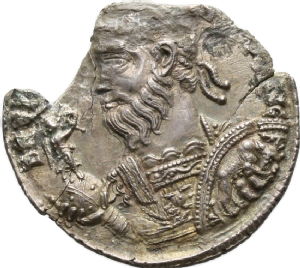 |
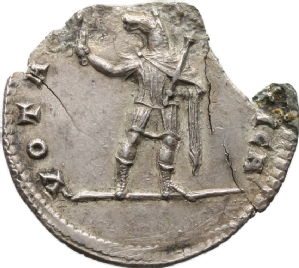 |
Fig. 1: AR, ‘Vota Publica’ token, Rome, AD 361-363 (24mm, 3.45g). Courtesy of the Ashmolean Museum, inv. HCR71367. © Ashmolean Museum.
The imagery and the reverse legend allow us to connect this specimen with a late Roman series, the ‘Vota Publica’ tokens, which were struck by the mint of Rome from the first Tetrarchy (AD 294–305) through at least the first two generations of the Valentinian dynasty (AD 364–378). These tokens display portraits of Roman emperors or Egyptian deities (Serapis, Isis, Hermanubis, or the jugate busts of Serapis and Isis) on the obverse, in conjunction with a variety of depictions referring to different aspects of Egyptian and Isiac cults on the reverse. Although auction catalogues and occasional academic contributions have mostly connected these artefacts to the Navigium Isidis, the renowned festival of Isis which was annually held on the 5th of March, the regular presence of the ‘Vota Publica’ legend as well as the dates of accession and death of imperial rulers that are portrayed on the obverses support instead the idea that these pieces were produced on the occasion of the annual vows (‘vota publica’) collectively pronounced for the health of the Roman emperor on the 3rd of January against the backdrop of New Year celebrations.
The token housed in Oxford, formerly in Prince of Waldeck’s collection (XVIII century), is of great interest not only for the high quality of its designs and workmanship, but also for the metal of which it is made, namely silver. Indeed, the use of silver does deviates from the common patterns seen for the ‘Vota Publica’ tokens, which were normally produced in brass and bronze. This raises questions about manufacturing methods and relevant changes that took place within token production during Julian’s reign.
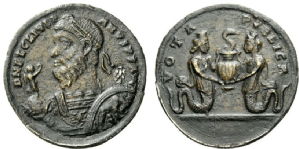 |
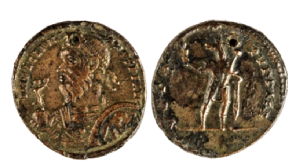 |
Fig. 2: a. AE, ‘Vota Publica’ token, Rome, AD 361-363 (24mm, 4.05g). Numismatica Ars Classica 92, 23-24.05.2016, lot 766. b. AE, ‘Vota Publica’ token, Rome, AD 361-363 (25mm, 6.30g). Courtesy of the Museo Arqueológico Nacional (MAN) of Madrid, inv. 2014/66/67. © Museo Arqueológico Nacional (MAN) of Madrid.
A closer look at the imagery of the token and its relationship to other surviving tokens of Julian from the same series allows us to make some remarks on its chronology and production context. Based on a recent classification of the available material (Bricault & Mondello, forthcoming), Julian’s ‘Vota Publica’ tokens can be sorted into five major groups consisting of die-linked specimens, which were struck in either bronze or brass in three modules, AE1-AE2 (c. 21-27mm) (Julian, Group 1) and AE4 (c. 12–15mm) (Julian, Groups 2–5). Interestingly, Julian’s effigy is shown here according to three variants. Of them, the obverse portrait displayed on the Oxford token is shared by some of the clusters from Group 1 showing different Egyptian images on the reverse (Fig. 2a). Moreover, die analysis shows that the Oxford silver token was issued with the same obverse and reverse dies that were used to strike a specimen made of bronze, now in Madrid (Fig. 2b). The imperial portrait found on these specimens is unparalleled within the official coinage, and was probably an original creation by the Roman mint expressly for the ‘Vota Publica’ series. Two other portraits attested on these tokens instead reproduce or imitate the imperial portraiture found on regular Roman coins: a left–facing and helmeted bust of Julian, holding a shield over his left shoulder (Julian, Group 2) (Fig. 3a), as found on the VOT X MVLT XX silver and bronze coin issues issued at most of the major mints in anticipation of Julian’s decennalia (Fig. 3b); and the common type of the imperial bust right, with cuirass and paludamentum, short or long–bearded (Julian, Groups 1–5) (Fig. 4a), as seen on the small VIRT EXERC ROMANOR bronzes by the Roman mint (RIC VIII, Rome, 327) (Fig. 4b) and, more generally, on solidi and large bronzes issued by other mints in AD 362–363.
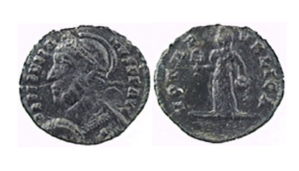 |
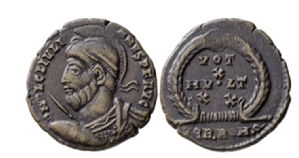 |
Fig. 3 a. AE, ‘Vota Publica’ token, Rome, AD 361-363 (15mm, 1.74g). Courtesy of the Museo Civico di Bologna, inv. 47046. © Museo Civico di Bologna. b. AE, VOT X MVLT XX coin, Rome, AD 363 (18.8mm, 3.17g) (RIC VIII, Rome, 329). Courtesy of the Münzkabinett der Universität Göttingen, inv. AS-04485 © Münzkabinett der Universität Göttingen.
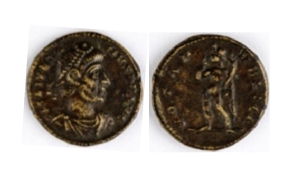 |
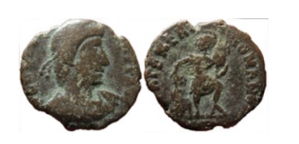 |
Fig. 4 a. AE, ‘Vota Publica’ token, Rome, AD 361-363 (14mm, 1.57g). Courtesy of the Museo Arqueológico Nacional (MAN) of Madrid, inv. 2014/66/203. © Museo Arqueológico Nacional (MAN) of Madrid. b. AE, VIRT EXERC ROMANOR coin, Rome, AD 362-363 (14mm, 1.32g) (RIC VIII, Rome, 327). From a private collection.
The imperial titulature, which reads D N FL CL IVLIANVS P F AVG (Group 1) or FL CL IVLIANVS P F [or P P] AVG (Groups 2–5), along with the comparison with coin imagery allow for a more precise chronology of these token issues. According to Kent, the title D(ominus) N(oster) seems not to have entered general use within Julian’s coinage until after the start of 363 (Kent 1959, p. 114; RIC VIII, pp. 46, 54). Following Kent’s suggestion, the silver token held in Oxford, as well as the large–sized ‘Vota Publica’ tokens from Group 1 bearing a long imperial legend including D N, might date back to the celebrations of the vota publica of the 3rd January 363, as also pointed out by the style of the imperial effigy with a long beard, which clearly refers to Julian’s later coinage. The same dating can be applied to tokens from Group 2, the obverses of which are similar to dies from the VOT X MVLT XX issues apparently struck by the Roman mint in AD 363 (RIC VIII, Rome, 328–330), although the former retained a short imperial titulature not found on the latter. Less clear is instead the chronology of the specimens from Groups 3-5. The portrait and the short imperial legend on the obverse of these pieces, as well as their size - matching the pre–reform VIRT EXERC ROMANOR issues (= AE4) - may date them to the previous year, that is the 3rd January 362, although one cannot completely rule out the idea that they were also part of the AD 363 token issue.
The existence of a ‘Vota Publica’ token made of silver clearly suggests that a small cluster was produced in precious metal within this late Roman series during the reign of Julian, in addition to the more common bronze and brass issues. While the actual purpose of these tokens remains debated (= devices issued as a means of pagan propaganda? Auspicious gifts distributed during New Year celebrations?), it is possible that the choice of manufacturing silver tokens resulted from a more general ‘revival’ of the ‘Vota Publica’ series which took place under Julian. Indeed, the evidence shows that the production of these specimens during the reign of the last Constantinian emperor saw a relative iconographic renewal of the reverse repertoire via the use of a new set of Egyptian types, as well as a reintroduction of the large-module denominations (AE1-AE2), which were earlier only struck for the first ‘Vota Publica’ issues at the time of the first two Tetrarchies (AD 294-305) and then replaced by mostly small-sized denominations (AE4) from Constantine I (AD 313-330/331). Such a ‘revival’ of this token series showing Egyptian religious iconography is not surprising in light of Julian’s religious reform and his (short-lived) attempt to restore Hellenistic polytheism as the state religion. However, this production pattern, based on a trimetallic system (silver, orichalcum, and bronze) for the ‘Vota Publica’ tokens, apparently did not succeed and was not followed by Julian’s successors (Jovian and the Valentinian emperors up to Gratian), who only resumed manufacturing these tokens in brass and bronze – or at least there is no evidence to demonstrate otherwise. Whatever the purpose of these tokens, it may be argued that the use of silver to strike some of Julian’s token issues may have been matched by a higher exchange value compared to that of brass and bronze specimens, which also had the effect of providing a more valuable appearance to the object and the same level of aesthetic quality as found on silver coins and medallions.
This blog was written by Cristian Mondello as part of The ‘Vota Publica’ Tokens from Late Antique Rome: Isiac and Egyptian Cults within a Christianizing Roman Empire project, which has received funding from the NRRP, Mission 4, ‘Education and Research’ – Component 2, ‘From Research to Business’ – Investment line 1.2, ‘Funding projects presented by young researchers’ (European Union – NextGenerationEU, proposal no. CFFE1C55). The project is hosted at the University of Messina, Italy.
Select bibliography
Alföldi A., Isis-szertartások Rómában a negyedik század keresztény császárai alatt = A Festival of Isis in Rome under the Christian Emperors of the IVth Century, Budapest 1937.
Bricault, L., & Mondello, C., Isis Moneta. The ‘Vota Publica’ Tokens from late antique Rome. Volume 1: Catalogue, London (forthcoming).
Kent, J.P.C., ‘An Introduction to the Coinage of Julian the Apostate’ (A.D. 360–3), The Numismatic Chronicle and Journal of the Royal Numismatic Society, 6.19 (1959), pp. 109–117.
RIC VIII = Kent, J.P.C., The Roman Imperial Coinage. The family of Constantine I. A.D. 337–364, Vol. VIII, London 1981.
December 07, 2021
Engraving Roman 'tesserae': the 'Vota Publica' tokens from Girolamo Tanini's collection
Since the sixteenth century, a special and enigmatic late Roman token emission, the ‘Vota Publica’ series, has received attention from antiquarians, dealers and collectors. These tokens, produced in either bronze or brass by the Roman mint, depict the effigies of Roman emperors from Diocletian (AD 284-305) to Valentinian II (AD 375-392) on the obverse (called the ‘imperial’ series). Instead of an imperial image they might also carry the busts of Serapis, Isis, or Hermanubis (or the jugate busts of Serapis and Isis) (called the ‘anonymous’ series). A number of ritual scenes and images referring to different aspects of Egyptian and Isiac cults are shown on the reverses, which are mostly accompanied by the legend ‘Vota Publica’ (= ‘public vows’). Due to the distinctive Egyptian religious iconography of these artefacts, a number of drawings or engravings of the ‘Vota Publica’ tokens appeared in several books, catalogues, and other contributions from the sixteenth to the early twenty centuries. These drawings reproduce, sometimes with a good degree of accuracy, some of the types found in the existing material, although the precise identification of the depicted specimens remains debated in most cases.
Two drawings reproducing ‘Vota Publica’ specimens are known to this author as showing an otherwise unattested obverse-reverse type combination. These designs were included by Girolamo (Hieronymus) Tanini in the plates of his ‘Supplementum’ to Banduri’s volume ‘Numismata Imperatorum Romanorum a Trajano Decio ad Palaelogos Augustos’ (Lutetiae, 1718), which was published in Rome in 1791 (Fig. 1)(Numismatum Imperatorum Romanorum a Trajano Decio ad Constantinum Draconem ab Anselmo Bandurio editorum Supplementum, Romae 1791). In this volume, Tanini catalogued hundreds of gold, silver and bronze coins from the reign of Trajan (AD 98-117) up to until that of Constantine XI Palaiologos (1149-1453). Most of the specimens recorded by Tanini existed as part his own collection, but others came from other collections or were taken from different books and catalogues. Girolamo Tanini was a priest and erudite greatly interested in numismatics, who served in Florence for the Rinuccini family as educator of Marquis Folco Rinuccini’s children Giovanni and Alessandro, as well as curator of the library housed in Palazzo Rinuccini. In this role, Tanini was also in charge of the numismatic collection of the Rinuccini family, which was initiated by Folco’s father, Marquis Carlo Rinuccini (1679-1748).

Fig. 1. Frontispiece of the ‘Supplementum’ by G. Tanini (1791).
In his ‘Supplementum’, Tanini described around seventy ‘Vota Publica’ tokens from both the ‘imperial’ and ‘anonymous’ series, most of which were part of his own collection. However, he only illustrated six of these specimens. Two of them, belonging to the ‘anonymous’ issue, came from Cardinal Stefano Borgia’s collection (1731-1804), and were later acquired by the Vatican. The other four were part of Tanini’s collection.
Of these, two display the pearl-diademed bust of the emperor Jovian facing right on the obverse, accompanied by the legend D N IOVIANVS P F AVG COS, while on the reverse is the type of Isis seated facing on high-backed throne, suckling Horus-Harpocrates (Fig. 2), or the type of Serapis-Agathodaemon and Isis-Thermouthis facing one another, carrying a sacred vase between them from which a serpent emerges (Fig. 3). The tokens depicted in these two drawings, labelled as AE2 (‘secundae formae’), might be identified with two rare specimens bearing the same obverse and reverse type and legend and with the same diameter, which are currently housed in the Vatican collection. The other two drawings provided by Tanini depict the draped bust of Isis facing left on the obverse, wearing a basileion and holding a sistrum in her right hand, while on the reverse is the image of Isis standing right on a galley with oars sailing right. Although these images are widely attested in the available material, none of the surviving specimens show a combination of these two types.
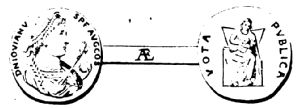 |
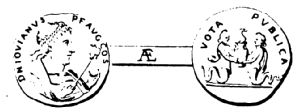 |
| Figure 2: Tanini 1791, p. 324, pl. VI. | Figure 3: Tanini 1791, p. 324, pl. VI. |
In the ‘Supplementum’, Tanini placed these two tokens under the coinage of Helena, the emperor Julian’s wife (died AD 360). As was common in his time, Tanini considered the busts of Serapis and Isis displayed on these tokens as disguised representations of Julian (AD 361-363) and Helena, following the idea that the production of some of these token issues was connected to Julian’s “pagan renaissance”. Tanini’s description of the two considered specimens is as follows:
1) TANINI 1791, p. 321, pl. VI:
Obverse: ‘VOTA PVBLICA (sic). Protome Isidis, vel Helenae, absque velo, cum flore loti, dextrorsum, d. sistrum, s. ad pectus gemmatum composita’.
Reverse: ‘VOTA PVBLICA. Isis sinistrorsum, stans in triremi, utraque manu velum regit’.
The first of the two specimens (Fig. 4) was labelled as AE3 (‘tertiae formae’) by Tanini. While the combination of the illustrated obverse and reverse types, with the legend VOTA PVBLICA occurring on both sides of the token, is not found in any of the known specimens today, it is worth paying attention to a similar specimen from the Vatican collection - Biblioteca Apostolica Vaticana (BAV) inv. no. Mt. Rom. Imp. Helena Iuliani 32. Although in a poor condition, this piece bears the same obverse type and legend as Tanini’s token, and the reverse also looks extremely similar with only one small difference: Isis has turned her head and is looking backwards (left), while on Tanini’s drawing Isis faces forward. It is tempting to assume that the specimen once owned by Tanini matches the Vatican piece, presuming that he misread the reverse type due to the poor condition of the token. However, no data on the acquisition of the piece by the Vatican collection is available. Moreover, the presence of a hole on the Vatican piece, which is not shown in Tanini’s drawing, may make this idea unlikely. If genuine, the piece described and figured in Tanini’s ‘Supplementum’ could provide evidence of an unrecorded ‘Vota Publica’ specimen.
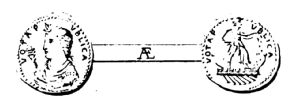 |
 |
| Figure 4: Tanini 1791, p. 321, pl. VI. | Figure 5: Tanini 1791, p. 322, pl. VI. |
2)TANINI 1791, p. 322, pl. VI:
Obverse: ‘DEA ISIS FARIA. Caput Isidis margaritis diadematum, collo duplici margaritarum monili ornato, humeris stolatis, d. sistrum’.
Reverse: ‘VOTA PVBLICA. Isis in triremi, sinistrorsum stans, velum tenet’.
The other specimen illustrated by Tanini (Fig. 5), labelled as A4 (‘quartae formae’), shows the same type combination of the previous piece, but it bears the obverse legend DEA ISIS FARIA instead of VOTA PVBLICA. As the available token specimens show, this legend was never used in the ‘Vota Publica’ series. Moreover, the obverse legend shown in Tanini’s drawing seems to incorporate two of the obverse legends found on the existing pieces with the bust of Isis, namely DE(ae) ISIDI (in the dative case) (Biblioteca Apostolica Vaticana (BAV) (inv. no. Mt. Rom. Imp. Helena Iuliani 30)) and ISIS FARIA (in the nominative case) (Fig. 6). If the piece drawn by Tanini was genuine, the legend DEA ISIS FARIA would be unique (an unicum). Actually, it is likely that the legend transcribed by Tanini was the result of a wrong interpretation. This is despite the fact that Tanini was aware that the legend ISIS FARIA, as well as the less common legend DE ISIDI, occurred on the obverse of the token specimens from the ‘anonymous’ series, as the specimens catalogued in his ‘Supplementum’ demonstrate.

Figure 6: AE, ‘Vota Publica’ token (19mm, 2.30g, 5h). Rome, IV century AD. Bertolami Fine Arts 24, 23.06.2016, lot 955, once part of the Archaeological Museum of Florence’s collection (MAF).
Sadly, the ‘Supplementum’ by Tanini is the only available source for the discussed specimens which, like much of the material published in his volume, are no longer traceable. Indeed, the Tanini collection is currently dispersed. This numismatic collection was incorporated at some point into the Ranuccini collection, which came in 1850 into the Medagliere Granducale of the Reale Galleria in Florence. In turn, the Medagliere Granducale was moved to the Archaeological Museum of Florence (MAF) since 1895. Regrettably, there is no trace of the ‘Vota Publica’ tokens described by Tanini either in the MAF collection or in their registers. As seen above, some of Tanini’s tokens may have been acquired by the Vatican collection at some point in the twentieth century, but the lack of data does not allow us to br certain on this point. Further archival research may hopefully shed light on the fate of the tokens that were once part of Girolamo Tanini’s collection.
This blog was written by Cristian Mondello as part of The creation of tokens in late antiquity. Religious ‘tolerance’ and ‘intolerance’ in the fourth and fifth centuries AD project, which has received funding from the European Union’s Horizon 2020 research and innovation programme under the Marie Skłodowska-Curie grant agreement No 840737.
Select Bibliography
- A. Alföldi, Isis-szertartások Rómában a negyedik század keresztény császárai alatt = A Festival of Isis in Rome under the Christian Emperors of the IVth Century, Budapest 1937.
- G. Capecchi et al., Palazzo Peruzzi. Palazzo Rinuccini, Rome 1980.
- H. Tanini, Numismatum Imperatorum Romanorum a Trajano Decio ad Constantinum Draconem ab Anselmo Bandurio editorum Supplementum, Romae 1791.
October 16, 2018
Converting Roman coins into tesserae: development and value
The conversion of Roman coins into coin-like objects is a practice documented during the imperial period. Although it is not always easy to date and determine the value of countermarks, incisions and other types of intervention on coins after their production, full academic awareness has not yet been acquired on the complexity of the reuse of coins in antiquity, which lost their previous economic function in order to acquire new meanings and purposes. In addition to pierced specimens – which were hung on the neck by a cord (funiculum) to be reused as amulets or jewels – official Roman coins were also transformed into tesserae by erasing their reverses and engraving Roman numerals on the surface instead.
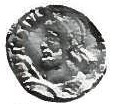 |
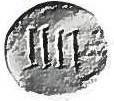 |
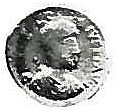 |
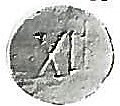 |
Figures 1-2: Late Antique coins with numerals scratched on the reverse. Both are bronze coins, BnF Paris.
The specimens shown above (Figs. 1-2), both held in the Bibliothèque nationale de France (BnF), bear on their obverses respectively the draped, cuirassed, and diademed bust of Julian the Apostate (on the left) and Theodosius I (DN THEODO-SIVS PF AVG) right (on the right). The reverses of both specimens were erased and smoothed, with the Roman numerals IIII and XII incised respectively. This phenomenon also appears to be attested on some earlier fourth-century bronze coins, e.g. those carrying the portrait of Maxentius and Constantius II (Alföldi 1975, Taf. 7, nos. 9-10) on the obverses. However, their conversion into tesserae may have occurred before, at the same time or even after that of the two pieces mentioned above.
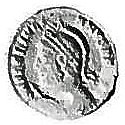 |
|
Figure 3: Bronze coin (Münzkabinett, Staatlichen Museen Berlin).
A specimen kept at the Münzkabinett in Berlin (Fig. 3) bears the bust of Julian the Apostate left on the obverse, while the image originally depicted on the reverse was erased and replaced with two engraved symbols, namely a palm branch and the monogram PE (“palma emerita”, “praemia emerita”?) whose meaning is controversial. Both motifs frequently occur on contorniates as well as on late Roman material culture, and they could allude to games and competitions or may have been used just as propitious and favourable symbols. Nevertheless, it is unclear how these motifs on contorniates were interpreted by their recipients, and even less clear how they connected with the function of the contorniates.
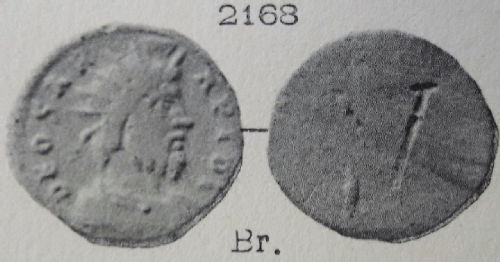 |
Figure 4: Vota Publica brass token (“Festival of Isis coinage”) (Collection H. Hoffmann, Médailles grecques et romaines, françaises et etrangers. Auktionskatalog Delestre-Rollin-Feuardent, 2-11 Mai 1898, Lot 2168).
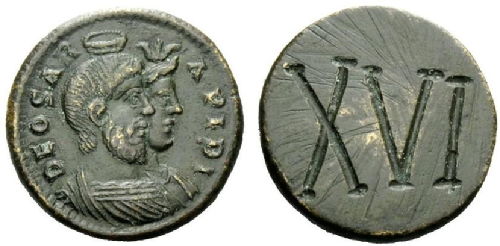 |
Fig. 5 Fig. 5: Vota Publica brass token (“Festival of Isis coinage”): Numismatica Ars Classica NAC AG, 23.05.2016, Auction 92, Lot 781. 2.75 g
Roman numerals could be engraved not only coins but even on tokens themselves, again converting them from one purpose to another. The two pieces shown above (Figs. 4-5) belong to the so-called “Vota Publica issues” (or “Festival of Isis coinage”) and, in particular, they have to be ascribed to the so-called “Anonymous series”, generically dated to the fourth century. A specimen carrys the radiate and draped bust of Serapis right, while the number V is incised on the reverse. Another piece, repeatedly published in auction catalogues since 1950, bears the crowned and draped busts of Isis and Serapis right, while the number XVI is engraved on the smoothed surface of the reverse. The obverse types of these two brass tokens show the same iconographies depicted on some Vota Publica specimens published by Alföldi (see Alföldi 1937, Taf. 7,31; Taf. 14).
Undoubtedly, the Roman numerals incised on the reverse of these coins and tokens evoke the Roman tesserae with numerals belonging to the Julio-Claudian period (27 BC – AD 68), which show the busts of members of the imperial dynasty or other depictions on the obverses, and Roman numbers generally within a laurel wreath – sometimes with the additional letters A or AVG – on the reverses. Also the so-called spintriae, characterized by erotic images (symplegma) on the obverses, carry Roman numerals on the reverses, at times connected by scholars to a ludic function (game counters) or an erotic context (“brothel tokens”). In addition to these two categories of tesserae, bone and ivory tokens also bear numbers written in both Latin and Greek on one side, and they were regarded as gaming counters on the basis of their findspots.
How should we interpret the coins as well as the Vota Publica specimens that were converted into tokens by engraving Roman numerals on their reverses? This kind of transformation of late Roman coins into tesserae suggests that they probably imitated earlier tokens carrying Roman numerals, and this presupposes a demand for this type of object also in the following centuries. The interpretation of these special “tesserae” is therefore closely related to the unknown function of earlier Roman tokens with Roman numerals, suggesting a continuity between the tokens of the earlier and later Roman period in terms of imagery and reception. New evidence could help to clarify the meaning of Roman numerals as well as the purpose and effects of these objects within Roman society across a longer term perspective.
This blog was written by Cristian Mondello, a British Academy Visiting Fellow at Warwick. This research is supported by the British Academy’s Visiting Fellowships Programme under the UK Government's Rutherford Fund.
Select Bibliography
Alföldi A., A Festival of Isis in Rome under the Christian Emperors of the IVth Century (Budapest 1937).
Alföldi A., ‘Heiden und Christen am Spieltisch’, JAC 18, 1975, pp. 19-21.
Bianchi C., ‘«Pedine alessandrine»: testimoni illustri di un gioco ignoto’, in Lambrugo C. & Slavazzi F. (eds.), I materiali della Collezione Archeologica “Giulio Sambon” di Milano (Milano, 2015), pp. 53-65.
Buttrey Th., ‘Spintriae as a Historical Source’, NC 13, 1973, pp. 52-62.
Campana A., ‘Le Spintriae: tessere romane con raffigurazioni erotiche’, in Morello A. (ed.), La donna romana. Immagini e vita quotidiana. Atti del convegno, Atina, 7 marzo 2009 (Cassino, 2009), pp. 43-96.
Küter A., ‘Roman tesserae with numerals – Some thoughts on iconography and purpose, in Rowan C., Crisà N. & Gkikaki M. (eds), Tokens: Culture, Connections, Communities, ed. by (London: Royal Numismatic Society, forthcoming).
Mittag P.F., Alte Köpfe in neuen Händen: Urheber und Funktion der Kontorniaten (Bonn 1999).
Perassi C., ‘Monete amuleto e monete talismano. Fonti scritte, indizi, realia per l’età romana’, Numismatica e Antichità Classiche. Quaderni Ticinesi 40 (2011), pp. 223-74.
June 20, 2018
Tokens and religious diversity in Late Antiquity
In the two centuries following the tetrarchic reform of Diocletian (AD 293-305), tokens continued to be regularly produced in the Roman West for a variety of purposes. Given their religious and social-cultural value, the evidence of late antique tokens and coin-like objects helps us to understand the gradual religious transformation within the Roman Empire of the fourth and fifth centuries AD, allowing us to trace wider patterns in the shift from a pagan to a Christian culture. Nevertheless, the connection between tokens and late Roman religious communities remains a relatively unexplored or inadequately understood phenomenon.

Fig. 1: 1 Bronze token from Département des Monnaies, Médailles et Antiques (BnF), Paris. 20 mm, 3.05 g
Remarkable is the bronze token shown above (Fig. 1), described in 1719 by B. de Montfaucon and held at the Département des Monnaies, Médailles et Antiques (at the BnF) in Paris. It was part of the collection of the Roman antiquarian Marcantonio Sabatini and was purchased by Abbé Le Blond, who brought it to France. This token carries on the obverse the bust of Alexander the Great left, wearing lion’s skin, with the legend ALEXSΔ-DRI; on the reverse is a donkey suckling a foal with a scorpion above, accompanied by the Christian legend D N IHV XPS DEI FILI-VS (“Dominus Noster Jesus Christus Dei Filius”).
This specimen is one of the so-called “Asina coins”, perhaps struck in Rome during the reign of Honorius (AD 395-423). They are a small group of very rare bronze tokens, on whose obverses are portraits of Alexander the Great or the Roman emperor, while the reverses carry Graeco-Roman images, including Hercules-Minerva, a centaur fighting a hero and even an erotic scene.

Fig. 2a: Bronze token with Honorius (obv.) and the donkey/foal (rev.), from British Museum. 15 mm, 0.8 g

Fig. 2b: Bronze token with female bust/Providentia (obv.) and the donkey/foal (rev.), from British Museum. 14 mm, 2.04 g.
These Asina tokens named for the donkey suckling a foal, which appears depicted on 4 other pieces. On the two specimens shown above, both housed at the British Museum, the donkey type on the reverse is accompanied by the legend ASINA (Latin for a donkey) (Fig. 2a), or the legend ROMA in the exergue (Fig. 2b). On the obverse of Fig. 2a is the portrait of the Roman emperor Honorius with the Urbs Roma Felix style, while in Fig. 2b the obverse carries a female bust with a crown ending in a crescent shape (Isis?) right, with the legend PROVI–DENTIA and R M below the bust.
Although the donkey was generally considered in the ancient world to be a symbol of fertility, a sacred animal, and an attribute of deities (e.g. Seth, Dionysus, Silenus, Vesta, Priapus), the image of the donkey suckling a foal is an unicum (unique) and has no comparanda in the material and visual culture of the Greek and Roman periods. According to some scholars, the Asina type might be an indirect satirical allusion to Jesus, who was mocked by pagans as a god with a donkey’s head (H. Tanini 1791; A. Alföldi 1951) (Fig. 3). By this hypothesis the “Asina coins” might be considered anti-Christian medals, part of a covert pagan propaganda against the oppressive policy of the emperor Honorius towards polytheistic cults.

Fig. 3. Fig. 3 The Alexamenos graffito (3rd century AD?) from Palatine Hill Museum, Rome.
However, historical and numismatic considerations oppose this interpretation. Other late antique tokens, like the so-called “Festival of Isis coinage” and the “contorniates”, carry pagan iconography and were used in the late Roman world despite repressive measures by the Christian empire. Although they too were interpreted by the early twentieth century scholarship as instruments of pagan propaganda, more recent hermeneutical approaches suggest instead that these coin-like objects had to be multifunctional. They were produced by a complex religious world, in which the categories of ‘Christian’ and ‘pagan’ are neither as homogeneous nor as mutually exclusive as is often assumed. Moreover, the contorniates often show Christian symbols (the cross, the Chi Rho monogram), portraits of Christian Roman emperors (e.g. Honorius, Theodosius II, Valentinian III, Majorian, Anthemius), and even Christian graffiti engraved on the surface of the pieces after their manufacture (Fig. 4).


Fig. 4. Fig. 4 Contorniate with Trajan and an engraved Chi Rho monogram in l. field (obv.) and a charioteer driving quadriga right (rev.), from Museo Archeologico Nazionale, Florence. Photo: S. Bani-M. Benci-A. Vanni 2012).
In light of the above, should the “Asina coins” be considered as an expression of satire or religious koine? The combination of Graeco-Roman and Christian features on the Asina tokens suggests how complex the relations between pagans and Christians were in late antiquity. At this moment in history religious groups interacted along a variety of axes, which at times lead to conflict, and at times competition, but which, above all, was a form of coexistence.
This blog was written by Cristian Mondello, a British Academy Visiting Fellow at Warwick.
This research is supported by the British Academy’s Visiting Fellowships Programme under the UK Government's Rutherford Fund.
Select bibliography:
A. Alföldi, A Festival of Isis in Rome under the Christian Emperors of the IVth Century (Budapest 1937).
A. Alföldi, ‘Asina. Eine dritte Gruppe heidnischer Neujahrsmünzen im spätantiken Rom’, GNS 2 (7), 1951, 57-66.
A. Alföldi, ‘Asina II. Weitere heidnische Neujahrsmünzen aus dem spätantiken Rom’, GNS 2 (8), 1951, 92-96.
A. Alföldi, E. Alföldi, Die Kontorniat-Medaillons. Teil 1: Katalog (Berlin 1976)
A. Alföldi, E. Alföldi, Die Kontorniat-Medaillons. Teil 2: Text (Berlin-New York 1990).
S. Bani, M. Benci, A. Vanni (eds), I medaglioni romani provinciali e contorniati nelle raccolte del Museo Archeologico Nazionale di Firenze. Vol. II (Massa Marittima-Follonica-Firenze, 2012).
C. Cavedoni, ‘Médailles du temps d’Honorius portant des signes chrétiens mêlés à des types païens’, RN 1857, pp. 309-314.
B. de Montfaucon, L’antiquité expliquée et représentée en figures (Paris 1719), II, 2, pp. 372-373, Pl. 168.
J.H. Echkel, Doctrina numorum veterum (Vindobonae 1798), t. VIII, p. 174; 289.
L. Lavan, M. Mulryan (eds), The Archaeology of Late Antique ‘Paganism’ (Leiden-Boston 2011).
F. Lenzi, ‘Di alcune medaglie religiose del IV secolo’, Bilychnis 2, 1913, 113-131.
S. Mazzarino, ‘Contorniati’, in EAA, Roma 1959, pp. 784-791.
P.F. Mittag, Alte Köpfe in neuen Händen: Urheber und Funktion der Kontorniaten (Bonn 1999).
M.R. Salzman, M. Sághy, R. Lizzi Testa (eds), Pagans and Christians in Late Antique Rome (Cambridge 2015).
H. Tanini, Numismatum Imperatorum Romanorum a Trajano Decio ad Constantinum Draconem ab Anselmo Bandurio editorum Supplementum (Romae 1791), p. 352, Pl. VIII.
October 26, 2016
Anubis Tokens and the Festival of Isis in Late Antique Rome
As part of the Token Communities project I have been examining the Roman lead tokens housed in the British Museum. Amongst the tokens are several that show the Egyptian goddesses Isis and Anubis. One example of these type of tokens is shown below: one side of the token shows Isis with a sistrum (a type of musical instrument associated with the goddess) and what may be a situla (a type of bucket). The legend on the left reads ACICI. The other side of the token shows the dog-headed god Anubis with a branch and a rather stylised sistrum.
 |
| Lead token with Isis on one side and Anubus on the other. |
The designs reminded me of the Isis coins of late antiquity, which are gathered together in Alföldi's 1937 book A Festival of Isis in Rome under the Christian Emperors of the IVth Century. Alföldi observed that even as late as the fourth century AD coins were being struck in Rome with the imperial portrait on one side and the Egyptian gods Isis and Sarapis on the other. Another series, which Alföldi called the 'anonymous' series, was also struck in the city. These had Isis or Sarapis on the obverse and various Egyptian motifs on the reverse: they did not name or show an emperor (an example is shown below). Alfödi suggested that this 'anonymous' series was created in the official mint after AD 378-9, the date at which coins showing the imperial portrait in association with Egyptian deities ceased. Alföldi believed that although the increasingly Christian emperors could no longer be associated with Isis or Sarapis, the (pagan) senatorial elite in Rome continued to produce coin-like objects for the festival of Isis, which could be given to their clients. Without the imperial portrait, these pieces weren't officially currency, Alföldi suggested, but instead were gifts given by select senators to their clients (and these pieces, in turn, may have later been used as playing pieces or small change).
 |
| 'Anonymous' issue with the portrait of Isis and figure of Anubis. |
On the anonymous series Anubis carries a sistrum and (stylised) caduceus, and is accompanied by the legend VOTA PVBLICA. This legend is also found on the coins struck with the imperial portrait, and probably references the fact that the festival of Isis in Rome was often connected with vows for the health and safety of the emperor. There are stylistic similarities, particularly with the sistrum held by Anubis, between the coins and the tokens. This, and the unusual appearance of Anubis at all, leaves me to wonder whether the lead tokens are not also from the same time period, and connected to the same, or a similar festival for Isis. If the elite were already creating 'anonymous' coin-like objects for use in the festival, perhaps the lead tokens with Anubis were a complementary or later development. While the Anubis British Museum tokens don't have any find data associated with them, they were catalogued by Rostovtzeff in his catalogue of tokens from Rome and the suburbs (Tesserarum Urbis Romae et Suburbi Plumbearum Sylloge no. 3190), and similar tokens were mentioned by Ficorini in his 1740 work. Specimens are also held in the Museo Nazionale in the Baths of Diocletian in Rome and in the Vatican, suggesting that maybe these are tokens that come from Rome, despite their Egyptian motifs. Other lead tokens also show strikingly similar imagery to the late antique coins associated with the festival.
Until further data is found this is just an idea, but perhaps we should add these tokens into the discussions of the yearly festival of Isis in late antique Rome.
This blog was written by Clare Rowan as part of the Token Communities project.
Anonymous series coin image reproduced courtesy of Numismatica Ars Classica, Auction 92 Part 1, lot 772.

 Clare Rowan
Clare Rowan

 Please wait - comments are loading
Please wait - comments are loading
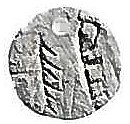

 Loading…
Loading…



